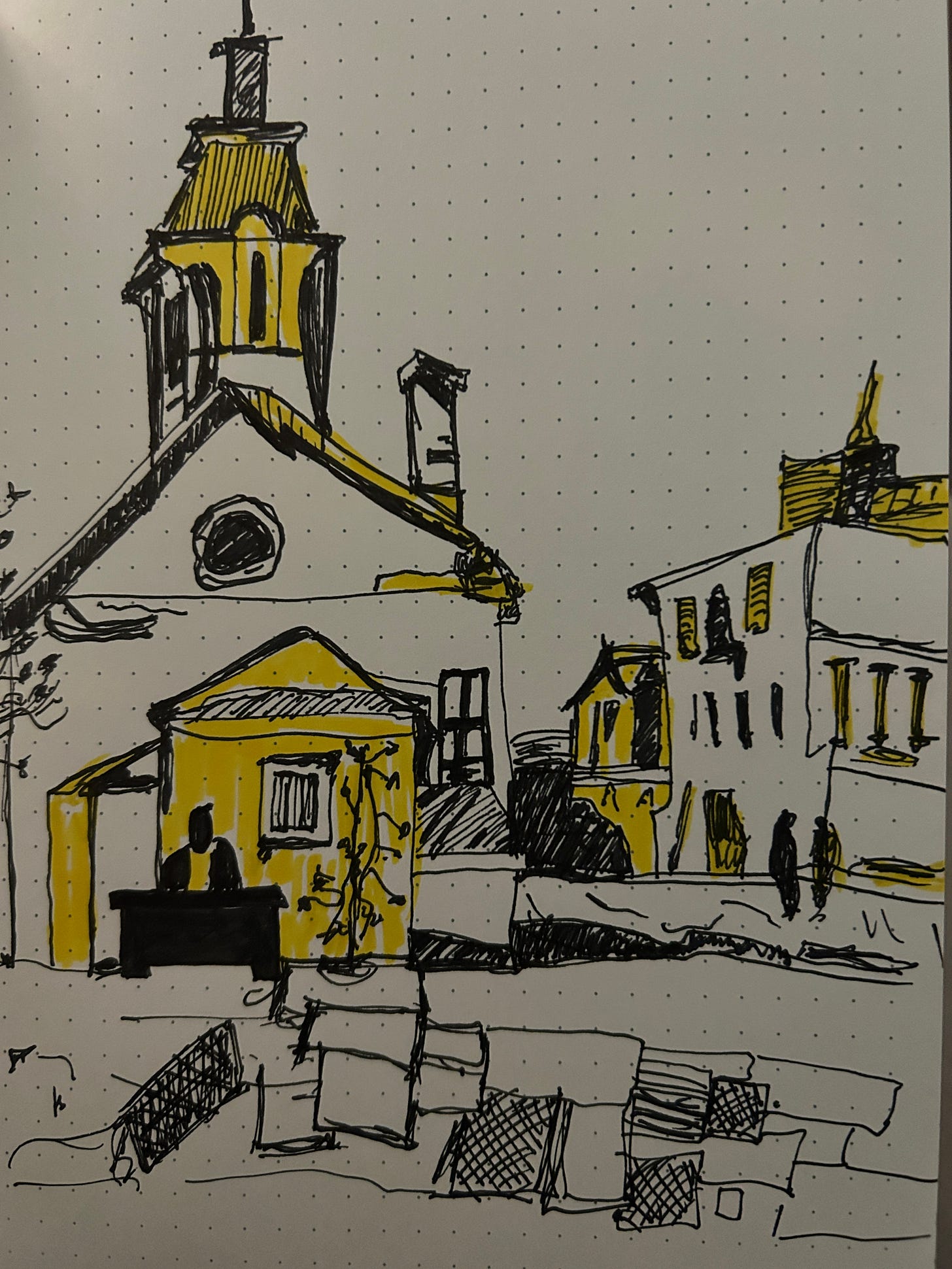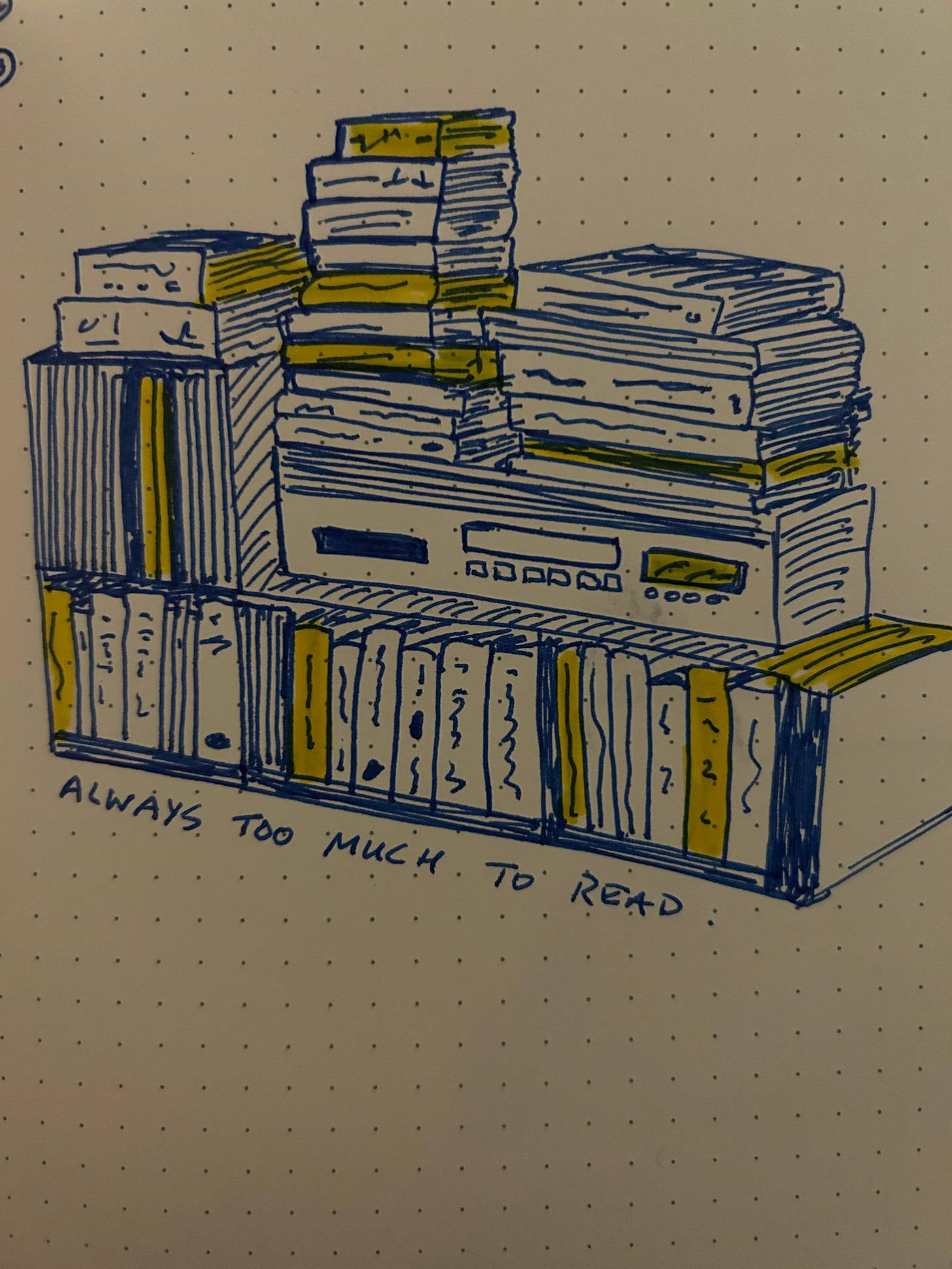Hey everyone,
I hope you are doing safe and well.
It’s been crazy busy here, as usual. I’ve been recording podcasts, showing builders around the house for quotes, sorting garden studio insurance (harder than you may imagine) and dealing with broken appliances (and replacements that don’t work).
I’ve also forgotten whether this is a management week or a creativity week; so much so that I reckon that construct is resigned to the bin. I’m just going to post what’s relevant, useful and on-top-of-my-mind each week. Hope that’s ok.
This week I’ve been thinking a lot about creativity.
This post had plenty of images - don’t forget to load them is you have them turned off in your email client.
At the start of each in-person session of my Communication Super Power Workshop, I run a small game designed to warm the group up but also show how creativity and the sharing of ideas is couched in fear but also show the attendees that this workshop is a safe space to share what’s on their mind. (Of course, I need to keep developing that safety and supporting it through the rest of the workshop too).
The game we play is designed around a Purdue creativity theory / game idea. I ask people to draw a picture of the person to the left of them. And I only give them 30 seconds to do so.
The initial reaction before they draw, is laughter, fear and worried smiles.
Then the excuses come out:
I can’t draw
I won’t have time
This will be really bad
Then the drawing commences (with lots of laughter) and I ask them to share their drawing after.
This is when they apologise or downplay their work:
I’m so sorry!
I said it would be bad!
This is not my strong suit!
When it comes to creativity we often make excuses before we’ve even begun. We doubt ourselves. We think we don’t have the skills (and we may not at the start). We are fearful of rejection. We may not even start.
When we do create or share something, we often start apologising for it, making excuses about it or belittling it or playing down our achievements. It’s human nature. It’s why creativity (bringing something to life that did not exist) is so hard.
And you can see why it’s hard in most workplaces.
We need time to think, dream and visualise something. (Imagination)
We need time and space and energy to bring that vision to life. (Creativity)
We need a safe space to share what we create (no matter the outcome). (Sharing)
We need to know/believe/trust that what we create is not going to be ridiculed, laughed at or mocked. (Feedback)
We need time, energy and space to keep doing this. Over and over again. (Learning)
It’s no suprise creativity is missing in many workplaces. Creating things is personal. We’re putting ourselves into what we create - and by default - we are then putting ourselves out there for critique, potential humiliation and rejection.
We make excuses to avoid doing it. We apologies when we do it. We downplay what we create.
That is until you do it so often that you get used to it. You build the creative muscle. You keep shipping. You learn. You keep trying. You focus on what is in your control (creating) and let others decide the value of what you create (easier said than done).
One of the best books on creativity and art I’ve ever read is Art & Fear: Observations on the Perils (and Rewards) of Artmaking by David Bayles. (affiliate link). It is a cracker.
“You make good work by (among other things) making lots of work that isn't very good, and gradually weeding out the parts that aren't good, the parts that aren't yours. It's called feedback, and it's the most direct route to learning about your own vision. It's also called doing your work. After all, someone has to do your work, and you're the closest person around.” Art & Fear: Observations on the Perils (and Rewards) of Artmaking by David Bayles.
Be like a kid. But kids suffer too.
The common advice or antidote to the fear of creativity is to be more like a kid. They have no fear right?
Well, maybe in their early years sure, but soon the fear kicks in and the excuses fly. Is it school? Is it parents? Peers? Social media? Not sure. But my kid built a Father Christmas at school last year. A real act of creativity - bringing to life his vision of Father Christmas in the form of a wooden tree decoration.
He said, before he even showed us, “it looks like it’s been through a fire”. I reckon it looked great and it had pride and place on our tree last year. But he made up excuses for his work.
Whether it’s school, peers, parenting, social media or a development of self awareness; kids soon develop the same fear of sharing their creativity.
Yet, creativity is essential for our lives and work. New products, tech, books, films, stories, developments in work practices, folklore - they all start in someone’s mind as an idea and are then brought to life. The trick is riding over the fear and bringing it to life.
Practice
To overcome the fear we must be exposed to it. Again. And again. And again until creativity is a part of our work and lives. It’s hard. And we will get it wrong and make mistakes. And if, in our workplaces, we have no place for mistakes we have no place for creativity whether that be art, a new product, a new service or a new way of doing things.
“Art is human. Error is human. Art is error.” Art & Fear: Observations on the Perils (and Rewards) of Artmaking by David Bayles.
Feedback is essential to creativity but the feedback needs to be constructive, supportive, from a place of care and from people that matter. This is hard in our workplaces.
Managers give feedback about new ideas and creativity. Leaders do too. Peers with bad intentions may also. At work it’s a melting pot of politics, ideas, creativity, opinions, conflict, support, care and everything else. Therefore, not all feedback will be helpful. Not all of it caring. And some of this may prevent people from trying again.
Creating a place where feedback is helpful and constructive around creativity is hard. But we must try if we wish to unleash people’s potential (and our own).
Is the pain of not creating too much?
I realised a few years ago that I’d got to the point where not creating what I wanted to create was more painful than the fear of rejection or critique.
“Artists don’t get down to work until the pain of working is exceeded by the pain of not working.” Art & Fear: Observations on the Perils (and Rewards) of Artmaking by David Bayles.
I think many companies are reaching this point too - the trick they need to work out though - is to create space, energy, time and safety to try and fail - over and over again. A space for people to bring new ideas to life, to potentially fail, to learn and to keep trying.
And that excites me in my work as a consultant.
I know people within the business are already trying to solve the big problems a company has with creative solutions. My job is to find these people, support them, shine a light, bring them together and create a safe passage to try and fail, over and over again, until we get it right.
At work today - do you feel you can express your creativity?
Do you have time, space and energy to think and bring to life that which you imagine? Do you face fears? Is the culture supportive of failure and mistakes and errors?
Do you have influence over the culture to nurture safe spaces?
Have you flexed your creativity muscle more and more to numb yourself from the fear of creating?
Creative solutions to work problems keep the business alive. Every business needs creativity, whether that be called innovation or dreaming big or bringing yourself to work - the goal is the same. Imagine things differently, bring that to life, potentially fail at first and then learn your way through it.
It’s interesting how, when a creative idea at work succeeds, people seem to think it was easy. What they don’t often see if the hard work and repeated mistakes and learnings that got to that outcome.
Go forth today and see if you can nudge more time, space and energy for creativity in your work and life. It’s hard. But I reckon it would be worth it.
And to give you some inspiration to try whatever you feel called to do - here’s some of my very rubbish drawings - as I learn how to draw, doodle and sketch. You see - I’m making excuses for my work already.
Interesting Links
A big shout out to long time subscriber, reader and emailer - Eckart who imagined something and created a music album. Creativity unleashed.
Worth a bookmark and deep study - how to talk about disability.
Women in the workplace report - interesting reading. Some good gains but women are still under-represented in leadership positions.
A lot of people often call me negative, mostly because of a focus on “problems” in business. But problems and opportunities are different sides of the same coin. If we overcome problems we open up opportunities. At least that’s my view. So, it was refreshing to see that challenging the durge of “optimistic thinking” that fills our social feeds and HR mantras with a little negative, skeptical, critical thinking - can be a good thing. The art of negativity is good read.
Stick the word “remote” in front of any article about management and you get clicks. But the advice in this article about “remote” management, should be true for “in-person” management. Good management, is good management.
The pschology of colour in marketing. Although this is an article about marketing - the same concepts bleed into our own work. Try using these colours to “sell” ideas in your next presentation for example.
Decent advice on pitching for the salary you want. Easy to write this - hard to hold your nerve. Develop good communication skills and it gets easier.
Until next week.
Rob..









